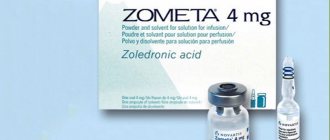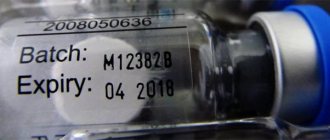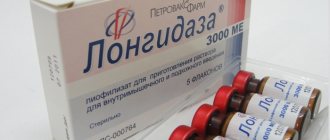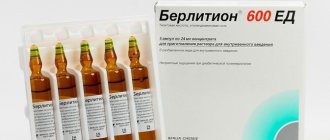Klacid
When using the drug, allergic reactions are possible: often - rash; uncommon - anaphylactoid reaction, hypersensitivity, bullous dermatitis, itching, urticaria, maculopapular rash; frequency unknown - anaphylactic reaction, Stevens-Johnson syndrome, toxic epidermal necrolysis, drug rash with eosinophilia and systemic symptoms (DRESS syndrome).
From the nervous system: often - headache, insomnia; uncommon - loss of consciousness, dyskinesia, dizziness, drowsiness, tremor, anxiety, increased excitability, screaming; frequency unknown - convulsions, psychotic disorders, confusion, depersonalization, depression, disorientation, hallucinations, dream disturbances (nightmares), paresthesia, mania.
From the skin: often - intense sweating; frequency unknown - acne, Henoch-Schönlein purpura, hemorrhages.
From the urinary system: frequency unknown - renal failure, interstitial nephritis.
From the side of metabolism and nutrition: infrequently - anorexia, loss of appetite; frequency unknown - hypoglycemia.
From the musculoskeletal system: infrequently - muscle spasm, musculoskeletal stiffness, myalgia; frequency unknown - rhabdomyolysis, myopathy, increased symptoms of myasthenia gravis.
From the digestive system: often - diarrhea, vomiting, dyspepsia, nausea, abdominal pain; uncommon - esophagitis, gastroesophageal reflux disease, gastritis, proctalgia, stomatitis, glossitis, bloating, constipation, dry mouth, belching, flatulence, cholestasis, hepatitis, including cholestatic and hepatocellular4; frequency unknown - acute pancreatitis, discoloration of the tongue and teeth, liver failure, jaundice.
From the respiratory system: infrequently - asthma, nosebleeds, pulmonary embolism.
From the senses: often - dysgeusia, taste perversion; infrequently - vertigo, hearing loss, ringing in the ears; frequency unknown - deafness, ageusia (loss of taste), parosmia, anosmia.
From the cardiovascular system: often - vasodilation; uncommon - cardiac arrest, atrial fibrillation, prolongation of the QT interval on the ECG, extrasystole, atrial flutter; frequency unknown - ventricular tachycardia, including pirouette type.
From the laboratory parameters: often - deviation in the liver test; infrequently - increased creatinine concentration, increased urea concentration, change in the albumin-globulin ratio, leukopenia, neutropenia, eosinophilia, thrombocythemia, increased blood concentrations of ALT, AST, GGTP, ALP, LDH; frequency unknown - agranulocytosis, thrombocytopenia, increased MHO value, prolongation of prothrombin time, change in urine color, increased bilirubin concentration in the blood.
From the body as a whole: very often - phlebitis at the injection site, often - pain at the injection site, inflammation at the injection site; uncommon - malaise, hyperthermia, asthenia, chest pain, chills, fatigue.
Infectious and parasitic diseases: infrequently - cellulitis, candidiasis, gastroenteritis, secondary infections (including vaginal); frequency unknown - pseudomembranous colitis, erysipelas, erythrasma.
Taking the drug in a high dose may cause symptoms of gastrointestinal disorders. In case of overdose, the unabsorbed drug should be removed from the gastrointestinal tract and symptomatic therapy should be carried out. Hemodialysis and peritoneal dialysis do not have a significant effect on the concentration of clarithromycin in serum, which is also typical for other macrolide drugs.
Indications for use
Infectious and inflammatory diseases caused by microorganisms sensitive to clarithromycin.
- Infections of the skin and soft tissues (all forms of release);
- Upper respiratory tract infections (all forms of release);
- Infections of the lower respiratory tract (all forms of release);
- Localized infections caused by Mycobacterium chelonae, Mycobacterium fortuitum and Mycobacterium kansasii (powder and tablets);
- Disseminated or localized mycobacterial infections caused by Mycobacterium avium and Mycobacterium intracellulare (powder and tablets);
- Eradication of Helicobacter pylori and reduction in the frequency of relapses of duodenal ulcers (tablets and lyophilisate);
- Odontogenic infections (0.25 g tablets only);
- Prevention of the spread of infection caused by the Mycobacterium avium complex in HIV-infected patients with a CD4 lymphocyte count of no more than 100 per cubic mm (tablets);
- Acute otitis media (powder);
- Mycobacterial infections (Mycobacterium leprae, Mycobacterium avium complex, Mycobacterium marinum, Mycobacterium kansasii) and their prevention in patients with AIDS (lyophilisate).
Analogs
- Arvicin;
- Arvicin retard;
- Binoculars;
- Zimbaktar;
- Kispar;
- Clubax;
- Clarbuckt;
- Clarithromycin;
- Clarithrosin;
- Claricin;
- Claricite;
- Claromine;
- Klasine;
- Klacid SR;
- Clerimed;
- Coater;
- Crixan;
- Seydon-Sanovel;
- CP-Klaren;
- Fromilid;
- Fromilid Uno;
- Ecositrin.
When choosing analogues, you must remember that the instructions for use of Klacid, price and reviews do not apply to drugs of similar effect. Replacing the drug is permissible only after the recommendation of a doctor.
The differences between Klacid and Klacid SR are that the latter drug is a long-acting drug, that is, the active substance is released more slowly.
Release form of the drug
For children, Klacid is available in the form of granules for preparing a suspension. The finished syrup is opaque with a white color and a fruity taste and contains 125 mg or 250 mg of clarithromycin per 5 ml. The drug is produced by the Italian pharmaceutical company Abbott SpA.
The granules are packaged in bottles of 60 or 100 ml. To prepare the antibiotic, just add the required volume of water. After this, you need to shake the bottle. The suspension can be used from 6 months.
Klacid tablets are used to treat adults or older children.
- Antibiotic Clarithromycin: indications for use;
- Look here for analogues of the drug Vilprafen;
- Macropen - indications for use and side effects: https://med-antibiotiks.com/instrukcii/pokazaniya-k-primeneniyu-antibiotika-makropen/.
How to take it for children?
Klacid for children can be used from the age of three. In most cases, children are prescribed Klacid suspension. Reviews for children indicate that this drug is quite effective. At the same time, the price of the suspension is quite high. The dosage for children is as follows: 7.5 mg per 1 kg of child’s weight twice a day. The highest daily dose is 500 mg.
Children over 12 years of age are prescribed 250 mg (tablets) twice a day. There is evidence that children tolerate Klacid more easily than other antibiotics. Therefore, the drug is often prescribed for sore throat, bronchitis, pneumonia, etc. However, we should not forget that side effects still occur.
Directions for use and dosage
Pills.
Take orally, regardless of food intake. The daily dose of Klacid for children over 12 years of age and adults is 0.25 g divided into 2 doses. For more severe infections (including mycobacterial, except tuberculosis), the dose is increased to 0.5 g 2 times a day. The duration of therapy varies between 5-14 days.
In cases of treatment of disseminated MAC infections in patients with AIDS, therapy is continued as long as there is microbiological and clinical effectiveness. The drug should be used in combination with other antibacterial agents that are active against these pathogens. The duration of therapy for other non-tuberculous mycobacterial infections is determined by the doctor on an individual basis.
The recommended dose of the drug for the prevention of infections caused by MAC for adults is 0.5 g 2 times a day.
Patients with odontogenic infections are prescribed 1 tablet 2 times a day for 5 days.
Patients with peptic ulcer disease caused by Helicobacter pylori can be prescribed 0.5 g of clarithromycin 2 times a day in combination with other antimicrobial drugs and proton pump inhibitors for 1-2 weeks.
Patients with renal failure take half the usual dose of clarithromycin (0.25 g once a day) or, for more severe infections, 0.25 g twice a day. The duration of therapy is no more than 2 weeks.
Lyophilisate.
An infusion solution prepared from the lyophilisate is administered intravenously by drip for 1 hour or more.
The recommended dose is 1 g per day, divided into two equal parts, each of which is administered after dissolving in an appropriate solvent.
There are no data on the dosage of Klacid for intravenous administration to children.
Intramuscular administration of the solution, as well as in the form of a bolus, is prohibited.
For patients with HIV infections, it is recommended to use oral forms of the drug.
The recommended dose of the drug for localized and disseminated mycobacterial infections for adults is 1 g per day in two divided doses.
Intravenous therapy in severe patients is carried out within 2-5 days with a possible subsequent transition (as prescribed by a doctor) to oral forms of the drug.
The dose of Klacid for patients with impaired renal function and creatinine clearance <30 ml/min is reduced by half.
Preparation of the solution:
- Add 10 ml of sterile water for injection to a bottle with 0.5 g of lyophilisate;
- Before administration, the resulting solution should be added to at least 250 ml of Normosol-M solution in 5% glucose solution, 0.9% sodium chloride solution, 5% glucose solution in 0.45% sodium chloride solution, 5% glucose solution in 0. 3% sodium chloride solution, 5% glucose solution in lactated Ringer's solution or Normosol-R solution in 5% glucose solution.
The reconstituted solution of Klacid, obtained after diluting the lyophilisate in sterile water, contains a sufficient amount of preservative and has a clarithromycin concentration of 0.05 g/ml. The solution is stable for 48 hours at 5°C or 24 hours at 25°C. It is recommended to use the reconstituted solution immediately after its preparation. If the solution is not used immediately after dilution, it is recommended to store it under aseptic conditions for no more than 24 hours at a temperature of 2 to 8 °C.
Powder.
To prepare the suspension, water is gradually added to the bottle with the powder up to the mark, then the bottle is shaken. Before each dose, it is recommended to shake the bottle of suspension well.
The suspension prepared from the powder is taken orally, regardless of food intake.
The recommended dose of the suspension for children with non-mycobacterial infections is determined based on the calculation - 0.0075 g per 1 kg of body weight 2 times a day. The maximum dose is 0.5 g 2 times a day. The duration of therapy is usually 5-10 days.
The recommended dose of the suspension for children with disseminated or local mycobacterial infections is determined based on the calculation - 0.0075-0.015 g per 1 kg of body weight 2 times a day.
Therapy must be continued as long as the clinical effect persists. The drug should be prescribed in combination with other antimicrobial drugs that are active against these pathogens.
The dose of clarithromycin for children with creatinine clearance <30 ml/min should be halved. The duration of therapy in such cases should not exceed 2 weeks.
What do the reviews say?
Reviews about Klacida are both positive and not too enthusiastic. Many patients note that the antibiotic is effective and significantly speeds up the healing process. But there are also stories that the drug provoked side effects, and as a result the doctor was forced to select a different antibiotic for treatment.
Parents who gave the drug to their children also leave different reviews of Klacid. No less important are the reviews of doctors, which indicate that experts consider this antibiotic to be effective and is often prescribed to both adults and children.
Drug interactions
It is strictly forbidden to take an antibiotic with the following medications: astemizole, cisapride, pimozide, terfenadine. Combining these drugs with clarithromycin can cause serious side effects on the heart. For example, arrhythmia, ventricular fibrillation or ventricular tachycardia.
Do not take with ergot alkaloids; simultaneous use with ergotamine can provoke the development of poisoning. Poor compatibility with rifabutin, as it reduces the concentration of the antibacterial drug in the blood.
Rifapentine, etravirine, neviparine or efavirenz may reduce the effectiveness of treatment by reducing plasma concentrations. Along with ritonavir, dosage adjustment is necessary; how much and in what quantities to take the medicine will be indicated by the attending physician.
With the use of insulin, it is necessary to regularly measure glucose readings, since the drug can provoke hypoglycemia. With quinidine, there is a chance of ventricular tachycardia with further transition to fibrillation. It is not advisable to use it together with warfarin and simvastatin. During therapy with sildanefil or tadafil, the dose of stimulants should be reduced.
Theophylline and carbamazepine increase the concentration of drugs in the blood. There is a risk of drowsiness and delirium with triazolam. With drugs, the concentration of digoxin in the blood increases. Diacordin and verpamil help lower blood pressure when used simultaneously with drugs.
special instructions
With prolonged use of antibiotics, colonies with an increased number of insensitive fungi and bacteria can form. In cases of superinfection, appropriate treatment should be prescribed.
There have been reports of cases of hepatic dysfunction with the use of clarithromycin (can be severe, but is usually reversible). There have been cases of fatal liver failure, mainly associated with the presence of serious concomitant diseases and/or concomitant use of other drugs.
Clarithromycin therapy should be stopped immediately if signs and symptoms of hepatitis appear - dark urine, anorexia, itching, jaundice, abdominal tenderness on palpation.
In cases of chronic liver disease, regular monitoring of serum enzymes should be carried out.
When using almost all antibacterial agents, incl. clarithromycin, pseudomembranous colitis may occur, with severity ranging from mild to life-threatening. Antibiotics can alter the normal intestinal flora and lead to the growth of Clostridium difficile. Clostridium difficile pseudomembranous colitis should be suspected in all patients who experience diarrhea after antibiotic use. After therapy, careful medical observation is necessary, as cases of the development of pseudomembranous colitis have been described after 2 months after taking antibacterial agents.
Clarithromycin should be prescribed with caution to patients with severe heart failure, severe bradycardia, coronary heart disease, hypomagnesemia, and when used simultaneously with class IA antiarrhythmic drugs. In these cases, it is important to regularly monitor the ECG for an increase in the QT interval.
Cross-resistance may develop to clarithromycin and other macrolide antibiotics, as well as clindamycin and lincomycin.
Due to the increasing resistance of Streptococcus pneumoniae to macrolides, it is important to conduct sensitivity testing when prescribing the drug to patients with community-acquired pneumonia. In cases of hospital-acquired pneumonia, the drug should be prescribed in combination with appropriate antibiotics.
Mild to moderate skin and soft tissue infections are often caused by Streptococcus pyogenes and Staphylococcus aureus. Both pathogens can be resistant to macrolides, so it is important to conduct a sensitivity test.
Macrolides can be prescribed for acne vulgaris, erysipelas, infections caused by Corynebacterium minutissimum, as well as situations where the use of penicillin is unacceptable.
If acute hypersensitivity reactions occur (Stevens-Johnson syndrome, Henoch-Schönlein purpura, anaphylactic reaction, toxic epidermal necrolysis, DRESS syndrome), you should immediately stop taking the drug and begin appropriate treatment.
There have been reports of worsening symptoms of myasthenia gravis in patients taking clarithromycin.
Patients with diabetes mellitus should be aware that the suspension contains sucrose.
During therapy, it is recommended to be careful when conducting potentially hazardous activities that require increased attention and speed of psychomotor reactions.







